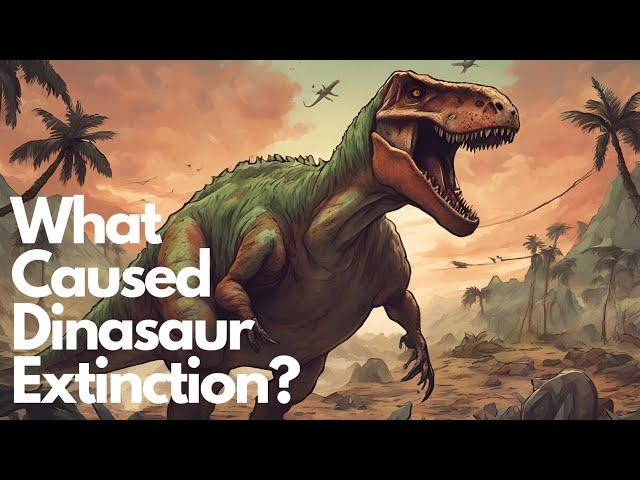
End of the Mesozoic and The Dinosaur Extinction
The question of what happened to the dinosaurs is significantly relevant to the question of primate evolution at the beginning of the Cenozoic era.
Avian dinosaurs are those that evolved into modern birds. They belong to the clade Dinosauria and are descendants of a group of theropod dinosaurs. Avian dinosaurs are characterized by feathers, a beak with no teeth, lightweight bones, and the ability to lay eggs with hard shells. They first appeared during the Mesozoic Era and survived the mass extinction event at the end of the Cretaceous Period, giving rise to the diverse array of bird species we see today.
Non-avian dinosaurs, on the other hand, refer to all dinosaurs that are not birds. They include a wide variety of species that lived during the Mesozoic Era, ranging from small, agile predators like Velociraptor to massive herbivores like Triceratops and long-necked sauropods like Brachiosaurus. Non-avian dinosaurs dominated terrestrial ecosystems for over 160 million years until they went extinct at the end of the Cretaceous Period around 66 million years ago. Unlike avian dinosaurs, non-avian dinosaurs are characterized by their lack of feathers, reptilian-like scales or skin, and various tooth structures adapted to their respective diets.
Their extinction, one of the largest mass extinctions in Earth's history, saw many species vanish. This event occurred at the end of the Cretaceous Period, amid massive volcanic eruptions, significant changes in temperature and sea level, and the impact of a large asteroid or comet. Scientists continue to debate these events' roles in the dinosaurs' extinction.
Recent advances in our understanding of dinosaur evolution and extinction have been driven by an exponential increase in dinosaur discoveries, with a new species named every 1.5 weeks. Precise radioisotopic dating has placed late Cretaceous dinosaur fossils in the context of significant events like asteroid impacts, volcanic activity, and climate change.
Key questions regarding dinosaur extinction include whether the extinction resulted from long-term events or brief, catastrophic ones, and identifying the most likely causes of the extinction.
Dinosaurs emerged during the Middle to early Late Triassic period, approximately 245–230 million years ago, gradually becoming dominant over the next 50 million years. They diversified into an array of species, thriving in terrestrial environments worldwide throughout the Mesozoic era. Non-avian dinosaur diversity fluctuated over their 160-million-year history, with extinctions occurring at normal background rates. Dinosaurs survived a mass extinction at the end of the Triassic with little impact on their diversity and another significant but poorly understood extinction event at the end of the Jurassic.
Non-avian dinosaurs disappeared from the fossil record at the end of the Cretaceous period, marking the boundary with the Paleogene period (K–Pg boundary), precisely dated to 66 million years ago. While it's conceivable that some local populations of non-avian dinosaurs might have briefly survived into the earliest Paleocene, the K–Pg boundary marks the definitive end of the dinosaur-dominated era.
The dinosaur extinction has been a subject of intense speculation with debates centred on whether the extinction was abrupt or gradual, whether it resulted from intrinsic dinosaur factors or external physical drivers, and if the latter, whether these drivers were terrestrial or extraterrestrial in origin. Additionally, there's a discussion about whether extinction had a single overriding cause or resulted from a combination of biological and/or physical factors.
The most renowned theory suggests that dinosaurs and other organisms vanished suddenly following a massive asteroid impact, triggering global environmental upheaval. This impact hypothesis gained significant support due to extensive research but still faces skepticism from some scientists who question its sole role in the extinction event. While evidence for an end-Cretaceous impact is clear, doubts persist because other significant earth system changes occurred around the same time, including intense volcanism, temperature fluctuations, and sea-level variations. Some argue that these factors individually, collectively, or in combination with the impact could have contributed to the extinction, suggesting a more complex picture than a single catastrophic event.
Avian dinosaurs are those that evolved into modern birds. They belong to the clade Dinosauria and are descendants of a group of theropod dinosaurs. Avian dinosaurs are characterized by feathers, a beak with no teeth, lightweight bones, and the ability to lay eggs with hard shells. They first appeared during the Mesozoic Era and survived the mass extinction event at the end of the Cretaceous Period, giving rise to the diverse array of bird species we see today.
Non-avian dinosaurs, on the other hand, refer to all dinosaurs that are not birds. They include a wide variety of species that lived during the Mesozoic Era, ranging from small, agile predators like Velociraptor to massive herbivores like Triceratops and long-necked sauropods like Brachiosaurus. Non-avian dinosaurs dominated terrestrial ecosystems for over 160 million years until they went extinct at the end of the Cretaceous Period around 66 million years ago. Unlike avian dinosaurs, non-avian dinosaurs are characterized by their lack of feathers, reptilian-like scales or skin, and various tooth structures adapted to their respective diets.
Their extinction, one of the largest mass extinctions in Earth's history, saw many species vanish. This event occurred at the end of the Cretaceous Period, amid massive volcanic eruptions, significant changes in temperature and sea level, and the impact of a large asteroid or comet. Scientists continue to debate these events' roles in the dinosaurs' extinction.
Recent advances in our understanding of dinosaur evolution and extinction have been driven by an exponential increase in dinosaur discoveries, with a new species named every 1.5 weeks. Precise radioisotopic dating has placed late Cretaceous dinosaur fossils in the context of significant events like asteroid impacts, volcanic activity, and climate change.
Key questions regarding dinosaur extinction include whether the extinction resulted from long-term events or brief, catastrophic ones, and identifying the most likely causes of the extinction.
Dinosaurs emerged during the Middle to early Late Triassic period, approximately 245–230 million years ago, gradually becoming dominant over the next 50 million years. They diversified into an array of species, thriving in terrestrial environments worldwide throughout the Mesozoic era. Non-avian dinosaur diversity fluctuated over their 160-million-year history, with extinctions occurring at normal background rates. Dinosaurs survived a mass extinction at the end of the Triassic with little impact on their diversity and another significant but poorly understood extinction event at the end of the Jurassic.
Non-avian dinosaurs disappeared from the fossil record at the end of the Cretaceous period, marking the boundary with the Paleogene period (K–Pg boundary), precisely dated to 66 million years ago. While it's conceivable that some local populations of non-avian dinosaurs might have briefly survived into the earliest Paleocene, the K–Pg boundary marks the definitive end of the dinosaur-dominated era.
The dinosaur extinction has been a subject of intense speculation with debates centred on whether the extinction was abrupt or gradual, whether it resulted from intrinsic dinosaur factors or external physical drivers, and if the latter, whether these drivers were terrestrial or extraterrestrial in origin. Additionally, there's a discussion about whether extinction had a single overriding cause or resulted from a combination of biological and/or physical factors.
The most renowned theory suggests that dinosaurs and other organisms vanished suddenly following a massive asteroid impact, triggering global environmental upheaval. This impact hypothesis gained significant support due to extensive research but still faces skepticism from some scientists who question its sole role in the extinction event. While evidence for an end-Cretaceous impact is clear, doubts persist because other significant earth system changes occurred around the same time, including intense volcanism, temperature fluctuations, and sea-level variations. Some argue that these factors individually, collectively, or in combination with the impact could have contributed to the extinction, suggesting a more complex picture than a single catastrophic event.
Комментарии:
End of the Mesozoic and The Dinosaur Extinction
Anthromedia
ERANZ Chief Executive Cameron Burrows on Breakfast
Electricity Retailers' Association of New Zealand
6 Superfoods That Reduce Creatinine Fast and Improve Kidney Health | Health & Mindful Habits
Health & Mindful Habits
Stefanie Hertel: Mein Vogtland - mei Haamet | MDR
MDR Mitteldeutscher Rundfunk
Counter Piracy and Pilot Rescue | Royal Marines
Royal Marines
John Davison - The Story Behind the Brilliant World Record Hundred
Dropped Again Cricket Podcast
The 3 BEST Deceptive Returns Of Serve In Badminton
Badminton Insight


























